| Intermediate Technology Education | Energy and Power Technology | Pre-Design | Topic 3 | Activity 6 |
Forms of Potential Energy
- Give examples of potential energy
- Investigate the applications of potential energy in technological problems and solutions
Forms of Potential Energy
As you learned in the previous activity, energy is either potential energy or kinetic energy. Each can take many forms.
Forms of potential energy include
- Stored Mechanical Energy
- Chemical Energy
- Gravitational Energy
- Electrical Energy
Stored Mechanical Energy
Stored mechanical energy is energy stored in elastic materials. A force is used to compress or stretch an elastic material such as rubber (for example, elastic bands, engine mounts) or springs (for example, vehicle springs, mouse traps, clothes pins, wind up clocks/toys/...). The energy is stored until the mechanism is released.
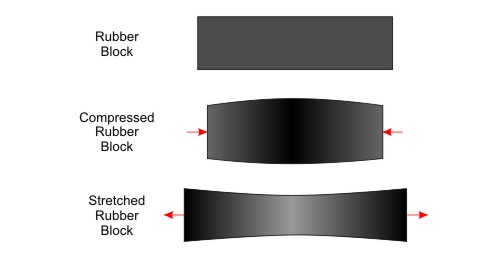
Figure Stored Mechanical Energy—Compressed and Stretched Rubber
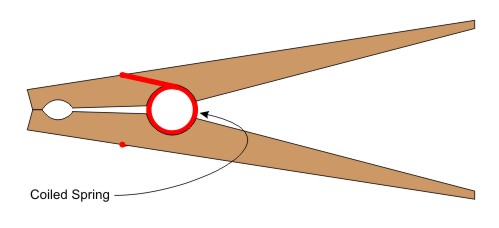
Figure Stored Mechanical Energy—Spring
Chemical Energy
Chemical energy is energy stored in the molecular structure of matter. It is the energy that holds the protons, electrons and neutrons of atoms and molecules together. Sources of chemical energy include
- Fossil Fuels
- Batteries
- Hydrogen
Fossil fuels (oil, Natural Gas, Coal, Wood). The energy is released by combustion (burning) which combines the fuel with oxygen in a fast chemical reaction.
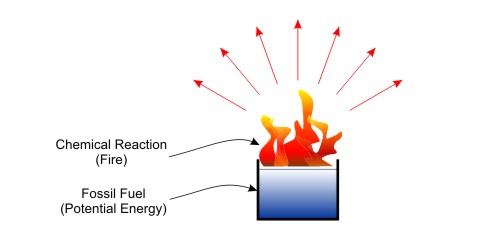
Figure Chemical Energy—Fossil Fuels
This form of chemical energy is used in all engines that rely on combustion to create heat and gases—which create great pressure, which creates motion. Example are gasoline engines (even tiny ones on model planes and boats), jet engines, and diesel engines (in cars, trucks, trains, ships, and electric generating stations).
Batteries (wide variety, including Lead-Acid, Alkaline, Nickel-Metal Hydride [NMH], and Lithium Ion). The energy is released as a flow of electrons when the terminals are connected together externally (through a load such as a light).
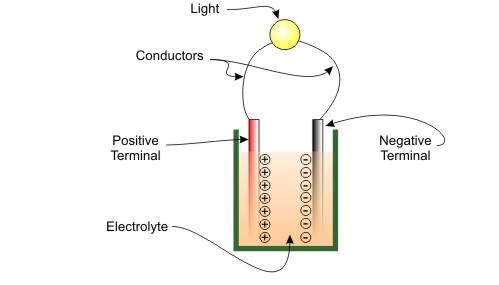
Figure Chemical Energy—Battery (single cell)
Batteries are used to power things from flashlights to cars and trucks. All fossil fuel powered vehicles that start when you turn a key use a battery to turn a small electric motor, which in turn rotates the engine until fuel ignites and the engine can run under its own power. Some vehicles are electric and run from rechargeable batteries.
Hydrogen (used in fuel cells). The fuel cell uses hydrogen and oxygen in a chemical reaction that creates water and electricity. As the hydrogen crosses a special membrane, it gives up electrons, and combines with the oxygen to form water. The electrons flow from the anode to the cathode, and when they are connected externally, the cell produces direct-current electricity.
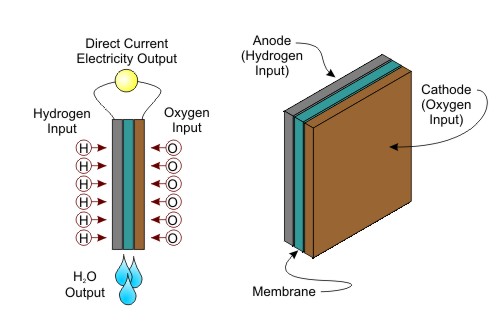
Figure Chemical Energy—Fuel Cell
Fuel cell technology is of great interest as it is seen as a way to cut dependence on fossil fuels, and at the same time reduce pollutants. Rather than the complex array of toxic chemicals exhausted by all fossil fuel engines, fuel cells exhaust only heat and water.
Gravitational Energy
Gravitational energy is energy an object has because of its position relative to a massive body like the earth. Everything on earth, including the 'stuff' of the earth (rocks, water, trees, people,...) has gravitational energy. Gravitational energy is released when the object is free to fall to a lower point on earth (i.e., get closer to the center of the earth).
Water is one of the major sources of gravitational energy that can be harnessed to produce electricity. Water pressure (force) is used to rotate turbines which rotate electric generators which ... (can you finish the sentence?)
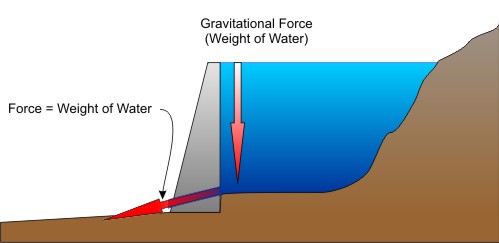
Figure Gravitational Energy—Water Pressure (Force). The higher the water column, the greater the weight (gravitational force) and the higher the water pressure (force) available to drive the turbine.
Electrical Energy
Electrical potential energy is created when there is a difference in electrical charge between two different locations. Electrical energy is considered a secondary type of energy since useful amounts of it are generally obtained by converting some other form of energy into electrical energy.
The major sources of energy for conversion to electricity are
- Chemical. Batteries are chemical reactions that convert the potential energy stored the differences in electrical charge in the two poles of the battery into electron flow in a circuit.
- Mechanical. Mechanical action employs the relationship between magnetism and electricity to convert the rotating mechanical motion of a generator (made the same way as an electric motor), into electrical energy. The generator can be powered by water power, wind power, tidal power, nuclear energy (heats water to make steam to drive the generator), or fossil fuel (coal heats water and ..., diesel engines drive the generator directly).
- Hydrogen. This emerging technology creates electricity directly from an internal chemical reaction.
See the Electricity Activity for more information on electrical energy.
For More Information
You may want to check these sites for more information on forms of energy
- The Secret Lives of Energy
- Types of Potential Energy
- Howstuffworks "How a Battery Works"
- How Fuel Cells Work
- Fuel Cells 2000 Fuel Cell Information Resource
- Hydroelectric power: How it works
- Howstuffworks "How Hydropower Plants Work"
- Chapter 5 Thermodynamics A series of examples of how very simple heat engines work.
When you are ready, move to Your Turn